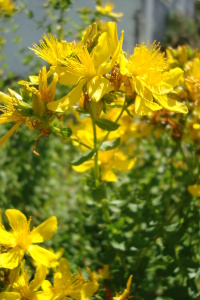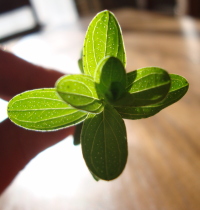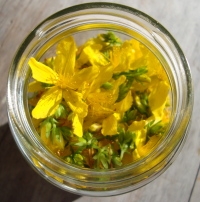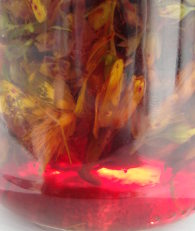
St John’s wort has been used centuries as a healing and magical herb. It’s been talked about a lot over the last decade due to it’s use as a treatment for depression. St John’s wort is also incredibly effective as an antibiotic and to heal neuralgic headaches and external injuries, burns and bruises. And that’s what I’ll be using my tincture for.
More on St John’s wort, how to grow, harvest, infuse and use it with lots of pretty pictures after the jump….
I’m choosing today to make my St John’s wort tincture as the new moon is said to bring an upsurge of energy. Surely that must be a good time to harvest for an infusion. I’m new to this whole moon planting thing but I thought I might have a look into it this year. More on this at a later time.
What does St John’s wort look like?
The stems are 30-60 cm tall, with opposing, stalkless, narrow, oblong leaves which are about 12 mm long. The leaves have lots of little translucent oil spots which make them look perforated (thus H. perforatum). These can clearly be seen when held up to the light.
Yellow, five-petaled flowers are approximately 20 mm across with tiny black oil glands and carried on many flowered terminal cymes. Each flower has lots of stamens about 12 mm in length. When flowers or seed pods are crushed, a reddish/purple liquid is produced. They appear in early – mid summer.
Always make sure you’ve got the right plant!
Growing St John’s wort
St Johns wort is incredibly easy to grow from cuttings. The plant grows from rapidly spreading runners, and taking one of these is easy. Emphasis on the rapidly – I suggest growing this one in a container. It’s a perennial, so will be with you for a while so long as you leave some to reseed each year.
Seeds apparently take a long time to germinate, up to 3 months, and growth can be slow in the first year.
Harvesting St John’s wort
During the year, I pick a couple of stems of St John’s wort and chamomile, and maybe some rosemary, lavender or valerian to use as a tea for headaches. As I have a plentiful supply at my back doorstep, I don’t tend to dry any.
Just before the height of summer when about half of the flowers are open, I go and pick the very top of the stems collecting the flowers and buds. I take about two-thirds of the ‘yellowness’ that is on the plant at that time, leaving the rest for attracting bees, seeding and generally just to look pretty.
Preparing St John’s wort tincture
I put all of those heads into a glass jar which I half fill with vodka (I like vodka), and the rest with filtered or recently boiled (but not boiling) water. The liquid quickly turns a lovely red. I leave it on a sunny window sill, catching all the sunlight it can’t get for two weeks. I shake it daily, and sometimes even move it around so it gets more sun. Then I strain the mix through some cloth. I let the liquid settle until it’s nice and red again and pour off the beautiful red without the sediment. The tincture gets stored in a cool, dark place.
Using St John’s wort medicinally
As I’m not a trained herbalist, I’m apprehensive to tell anyone to take therapeutic doses of herbs internally. But after lots of reading, this is the summary of what I’ve found.
Some of the many uses that have been described include: Sedative, anti-inflammatory, anti-depressant, antiviral, antibiotic and astringent.
When taken internally the herb stimulates both gastric and bile secretions and is effective in irregular menstruation. It has been shown to improve blood circulation.
Use for anxiety, nervous tension, irritability or emotional upsets. A dropper-full of tincture can be taken twice a day for nervous tension, exhaustion and depression. For childhood bed-wetting, give 5-10 drops at night.
An infusion or tincture of St John’s wort can be used to bathe wounds, sores, bruises and burns. It is one of the most effective agents for assisting in the healing of external injuries.
Other uses for St John’s wort
St John’s wort has been associated with magic since the Greeks gave it the name hypericon. This indicated that herb purified the air because the smell was strong enough to drive away evil spirits.
Leaves can be used in salads. Flowers can be used in ice cubes, just pop them in the tray and fill with water – try to push them down a bit. They look great in a gin and tonic.
Credits:
This post has been written from my own experience and reading over the years. To ensure I gave you the best information, I found three other women doing the similar things. Thank you Altnature.com, the delightful Kitchen Witch and Henriette.
All photos are from my garden.




Thank you for the mention… just wanted to update that I wrote the sjwinfo page over ten years ago, and am still using St. Johnswort to keep the blues away and for ADD!
Thanks again!
Karen